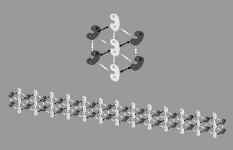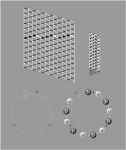|
Models of Energy and
Information Transfer
(click on
the picture to enlarge it)
Figures courtesy of Jeffrey
Satinover from his forthcoming book
|
|
|
|
 |
|
Traveling
kink or boundary that emerges from the requirements of interacting
ferromagnetic spins and chemical
waves. |
|
|
|
 |
|
Double
Potential Well for the tubulin dimer. The favored locations for the
mobile electron is in a pocket formed by the sub-unit
proteins. |
|
|
|
 |
|
Conformational
�kink� traveling along a MT. �a�
represents a domain where the mobile electron is in the a
sub-unit
of the tubulin proteins, orienting the dipole in the direction of
travel. �b�
represents a domain where the mobile electron is in the b
sub-unit of the tubulin proteins, orienting the dipole roughly
against the direction of travel.
|
|
|
|
 |
|
2D
Arrays forming tubes, with and without skew. |
|
|
|
 |
|
Two
conformations of tubulin based on which subunit has the mobile
electron. |
|
|
|
 |
|
TOP:
Favored tubulin neighborhood pattern. BOTTOM: When linked, the
neighborhoods form a consistent pattern, but with a skew. When
wrapped, the ends will be inconsistent with the rest of the
array. |
|
|
|
 |
|
Circumferential
Frustration in a MT. TOP LEFT: Arrows represent forces between
dipole sites located at the intersections of the lattice Black
arrows are repulsive, white attractive. TOP RIGHT: The same lattice,
wrapped, shows left-handed (black) and right-handed (white) helical
lines that are symmetrical. But the purely longitudinal direction
has only white lines. The black and white arrows illustrate one sequence with
minimal-energy attractive (+) and repulsive (�) dipole forces. When
wrapped, these will form a closed circle of neighbor-to-neighbor
forces. BOTTOM LEFT: The same arrangement of minimal-energy
attractive (+) and repulsive (-) dipole forces is shown here forming
a closed circle�but frustration ensues as no arrangement is
perfectly consistent.
BOTTOM
RIGHT: The arrangement of tubulin states that would correspond to
the frustrated lattice structure and the particular closed circle
path indicated
previously. |
